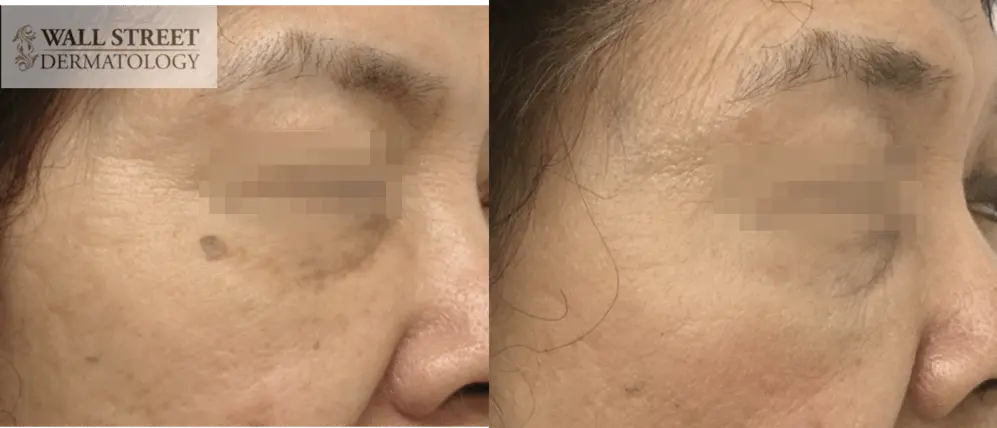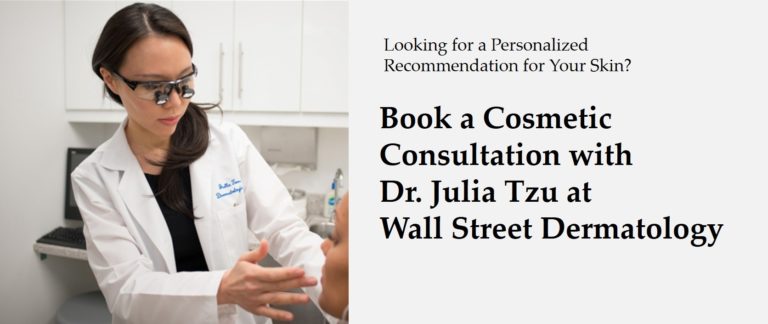Clear Your Complexion:
Seborrheic Keratosis Treatment NYC
Repair your skin through expert technique and exquisite attention to detail
- Last Updated: May 13, 2025
- By: Julia Tzu, MD FAAD
Seborrheic Keratosis Results at Wall Street Dermatology

A seborrheic keratosis is a common, benign skin growth that is most often found in older populations but can also be found in younger individuals. It typically takes the shape of a round but rough growth, varying in color between a dark brown, tan, or skin-colored, with a “stuck-on” appearance. These growths usually appear on a person’s face, shoulders, chest, and back, and while they can develop at any age, they will be most noticeable in someone past the age of 50. While these growths are benign and considered harmless, they are often removed for cosmetic reasons.
At Wall Street Dermatology, we are experts at seborrheic keratosis treatment in NYC. If you have a seborrheic keratosis that requires treatment, Dr. Tzu and the team at Wall Street Dermatology can help you remove your seborrheic keratosis with minimally invasive treatments for the best cosmetic outcome.
Causes of Seborrheic Keratoses
Most experts don’t completely understand what causes seborrheic keratoses. Some experts have identified a likely familial connection to the development of seborrheic keratoses, so if there are others in your family who have these skin growths, it’s possible you will inherit them as well.
Why Remove a Seborrheic Keratosis
Seborrheic keratoses are harmless benign skin growths, so removal is considered elective. However, they are often perceived as cosmetically bothersome due to their rough and discolored appearance. Some individuals have numerous seborrheic keratoses on the face or back, which causes the skin to appear rough in texture and uneven in color. At Wall Street Dermatology, we have a variety of treatment options to assist in minimally invasive cosmetic removal of seborrheic keratoses.
Although seborrheic keratoses themselves aren’t cancerous, it is important to follow up with a dermatologist if there are changes to any growths, such as rapid growth, color changes, bleeding, or problems with healing.
Our Seborrheic Keratosis Treatments
When it comes to addressing seborrheic keratoses, you’re in capable hands with our esteemed dermatologist, Dr. Tzu, a recognized authority in the field of cosmetic dermatology. We offer a range of effective treatment options tailored to your specific needs, including laser treatments, Hyfrecation (electrodessication), and shave removal for larger seborrheic keratoses.
Lasers Treatment For Seborrheic Keratosis
One option to treat thin seborrheic keratoses is laser removal, which uses an intense beam of light to selectively destroy the brown portion of the seborrheic keratosis. Seborrheic keratosis laser removal is minimally invasive and minimize scarring. Multiple treatments may be required to remove a seborrheic keratosis.
Laser Procedure
A laser procedure often won’t require numbing medicine, but if it is needed, a topical anesthetic can be applied to your skin to numb the area. Dr. Tzu then directs the beam of laser light at the seborrheic keratosis, which instantly destroys the cells of the seborrheic keratosis. This type of seborrheic keratosisis removal is brief overall, and patients are able to return home immediately after.
Seborrheic Keratosis Removal Healing Time
Once the laser treatment is complete, the treated area may initially appear gray and will then darken over the course of the next two weeks. Seborrheic keratosis removal aftercare can include vaseline which may be applied to keep it moist and promote maximum healing. The treated area must be protected from sun exposure to minimize hyperpigmentation. The lesion will then eventually fall off over the course of two weeks.
Laser Treatment Results
When you’ve fully recovered from your laser treatment, the appearance of your seborrheic keratosis should be significantly reduced, if not eliminated completely. There may be some mild discoloration or pinkness, which fades over time. It is important to avoid sun exposure in the treated areas to prevent hyperpigmentation.
Hyfrecation (Electrodessication)
Another type of seborrheic keratoses removal is hyfrecation (also known as electrodesiccation), which is similar to a laser procedure but utilizes gentle amounts of electric energy to remove the growth. Hyfrecation can remove larger and thicker seborrheic keratoses than laser treatments. Multiple treatments may be necessary to remove seborrheic keratoses.
Hyfrecation Procedure
Prior to the procedure, Dr. Tzu gently numbs the treatment area using injectable lidocaine or topical numbing medication. A pen-like surgical tool then delivers a precisely controlled amount of electricity to the seborrheic keratosis, which serves to peel off small layers of skin. Much like laser treatment, hyfrecation does not take much time to complete, and most patients will be able to return to their daily activities immediately following treatment.
Seborrheic Keratosis Removal Healing Time
After hyfrecation treatment, a seborrheic keratosis will appear crusted or blackened for 1-2 weeks. This is equivalent to a small scab, and a small amount of vaseline can be applied to promote healing. Seborrheic keratosis removal aftercare should include protecting the skin from sun exposure to minimize hyperpigmentation. There should be minimal pain or discomfort during seborrheic keratosis removal healing time.
Hyfrecation Results
After the scab from the hyfrecation treatment falls off, patients should notice that the post-treatment site is pink or discolored. This will eventually become the same color as the surrounding skin after a few weeks of healing, and depending on how deep the scab is, the treated area should be fully healed after a couple of months.
Shave Removal
For larger seborrheic keratoses, a shave removal may be required to remove the lesion. Sometimes, this procedure may be performed in combination with hyfrecation for the best cosmetic outcome.
Shave Removal Procedure
Shave removal utilizes a surgical blade to debulk and pare down the majority of the lesion. Local anesthesia is first injected into the lesion for numbing. A surgical blade then carefully sweeps through to flatten the lesion so that it is flush with the rest of the skin. This procedure is similar to the shave sculpting technique used in some mole removals.
Seborrheic Keratosis Removal Healing Time
After shave removal, the base of the lesion will be raw and will take time to heal. This can take several weeks for skin to grow back at the shaved area. Proper wound care must be exercised with vaseline or bacitracin covered by a bandage. The area must be protected from sun exposure to minimize hyperpigmentation. There should be minimal discomfort during the seborrheic keratosis healing time.
Shave Removal Results
The treated area will initially be raw at the base. It will take several weeks for skin to grow back, during which time the skin must be kept moist with ointment and covered by a bandage. After the skin heals over, the treated area will be pink, and it will take several months for the pink discoloration to fade away.
Seborrheic Keratosis Treatment Cost in NYC
Seborrheic keratosis treatment in NYC typically costs between $450 to $2,000 per treatment session. Seborrheic keratosis removal costs will depend on the number of lesions, size, and location of the growth, and the specific treatment being used. These procedures are considered elective, so removal will not be covered by insurance.
Schedule a Consultation With a Triple Board-Certified Dermatologist
To discuss what the best treatment option in NYC is for your seborrheic keratosis, schedule a consultation with Dr. Tzu today. We pride ourselves on delivering results that restore and enhance the natural beauty of your skin. When you’re in our care, you get the expertise of trained professionals committed to your overall well-being.
Seborrheic Keratosis Removal FAQ
What are seborrheic keratoses?
Seborrheic keratoses are common, benign skin growths that can appear in a range of colors, including white, pink, brown, or black. They often have a distinct “stuck-on” appearance, resembling waxy or wart-like bumps on the skin. Their texture can vary from smooth and velvety to rough or greasy, and they frequently develop on the face, chest, shoulders, and back, especially as people age.
How do you prevent seborrheic keratoses from forming?
Seborrheic keratoses are not completely preventable, as they are largely influenced by genetics and aging. However, protecting your skin from excessive sun exposure by wearing sunscreen and protective clothing may reduce the likelihood of their development over time. Maintaining a healthy skincare routine with gentle exfoliation and moisturizing can also support overall skin health, but these growths may still appear as part of the natural aging process.
How fast does seborrheic keratosis grow?
Seborrheic keratoses develop slowly over time, growing gradually rather than appearing suddenly. Some may take months or even years to reach their full size, while others may remain small and unchanged for long periods. Although they are benign, any rapid changes in size, color, or texture should be evaluated by a dermatologist to rule out other skin conditions.
Can I remove seborrheic keratosis myself?
Seborrheic keratosis should only be removed by an experienced, board-certified dermatologist. Only dermatologists are expertly trained in the diagnosis and management of various skin growths. Before any removal takes place, a proper diagnosis must be rendered to ensure that the growth is not cancerous, as treatment options for cancerous growths are vastly different from treatment options for benign growths. Improper self-removal of any skin growth can lead to scarring, infection, and other untoward outcomes.
Where do seborrheic keratoses grow?
Seborrheic keratoses can develop almost anywhere on the body, except for the palms of the hands, soles of the feet, and lips. They most commonly appear on the scalp, face, neck, shoulders, and back, where they may form in clusters or as isolated growths. While they can occasionally develop in less common areas, they typically do not affect mucous membranes or pressure-bearing regions of the body.
Can seborrheic keratoses be removed?
Seborrheic keratosis can be effectively removed through various methods, including laser treatment, hyfrecation, and cryotreatment. Removal is simple and safe, allowing patients to return to their everyday activities with minimal aftercare.
What is the best treatment for seborrheic keratosis?
Most available treatments for seborrheic keratosis are effective at eliminating the growth, but some treatments are more cosmetically elegant than others.
Hyfrecation is one of the most effective and cosmetically elegant treatments, although it sometimes needs to be combined with a surgical shave for large seborrheic keratoses. Laser treatment can also significantly reduce the appearance of a seborrheic keratosis, but is most effective for very thin seborrheic keratoses. Freezing or cryotreatment is used for numerous skin conditions and can be used for seborrheic keratosis, but can often leave more discoloration after treatment and is not considered as cosmetically elegant as hyfrecation and laser.
Should seborrheic keratoses be removed?
Whether or not a seborrheic keratosis needs to be removed is more of a personal decision, as it is a benign lesion that does not medically require treatment. Most people remove them for cosmetic purposes. Sometimes, a seborrheic keratosis can become inflamed and bleed, and this may be a reason for removal as well.

